 Tank of the Month
Tank of the Month
Tank of the Month
Brad Blankenship's (Mantis) Reef Aquarium
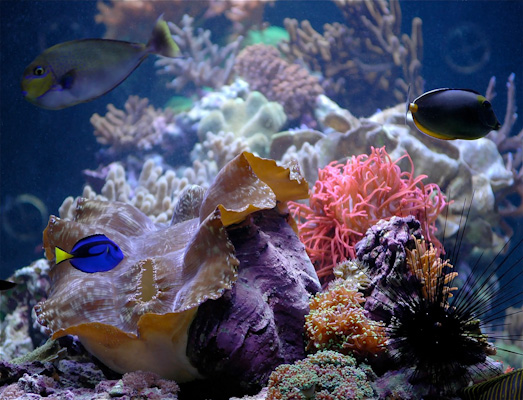 |
Introduction
My name is Brad Blankenship and I share the interest in this hobby with my wife, Maryann. We live in Columbus, Ohio with our son Cory who is ten.
My wife has always been supportive of my sometimes radical ideas, “Hey honey what if we put a 400-gallon aquarium in the middle of the entryway of our brand new home?".
History
For as long as I can remember I have been fascinated by the sea and the wondrous creatures that call it home. Considering I live in Ohio my interest in the sea was not always easy to pursue. When I was in my early teens my parents would take me to Byerly's aquarium. Right as you entered the door they had a display tank with a Toadstool Leather (Sarcophyton sp.) that was two feet in diameter. From then on I was hooked and the die was cast. It was only a matter of time before I would become a Reefkeeper and Diver. My early reef tank was a 120 US gallon corner aquarium, and for the time, was fairly successful.
I have been in this hobby for over 20 years, well before the birth of the internet and Reef Central. Back then I read everything I could get my hands on, including Martin Moe, Julian Sprung, and Charles Delbeek. These authors all gave me a good base of knowledge. This hobby is first and foremost about quality information. When I found Reef Central in 1999, and the ease with which this information could be shared, I knew the game had changed.
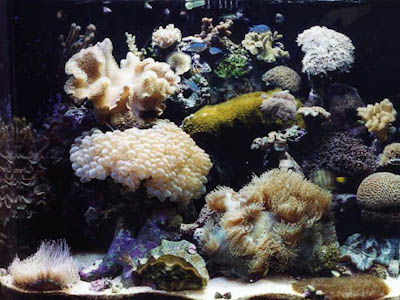 |
System Design and Concept
I spent a lot of time planning out my current system. I knew that I wanted a large display aquarium, viewable on 3 sides, with a suspended canopy. I wanted it to be as clean looking and quiet as possible. The aquarium was custom made of 3/4” low-iron glass. It measures 80” x 40” x 30” and has a volume of 400 US gallons. The finished product has definitely met or even exceeded my expectations.
The aquarium is rimless on the short viewable side while on the opposite short side I have my overflow and my “Wall'O'Tunze”. The overflow is built into the center and surrounded on both sides of the overflow are built in custom designed dual wave boxes. Combined, the Tunze pump out 20,000 gallons per hour, either in a pulsed wave action or by altering combinations of pumps throughout the day to keep the flow random. I control the Wall'O'Tunze with a Tunze 7096 Multicontroller. When the pumps are in wave mode I get a massive 2” wave that is seen moving throughout the 400-gallon tank (see video). When I designed the tank, I made sure to lower the water level to accommodate this wave. This keeps the water in the tank when the wave crests. It is by far the most impressive design feature of this tank.
Due to all the flow, sand really was not an option. I created a faux sand bed using Envirotec Lite Epoxy, sand, and Starboard. For those that do not know of Starboard, think of it like a kitchen plastic cutting board material. The epoxy and sand were mixed together to a consistency of brownie batter and applied to the Starboard. After it cured, it was placed into the aquarium. This allows me the option to remove my faux sand bed if needed. Not only does it look like sand, but it turned out to be a really great surface to attach zoanthids and mushrooms.
I made a suspended canopy for the lights out of oak and art glass. This makes access to the aquarium for cleaning, maintenance, and feeding very easy. By suspending the canopy it opens up the top of the aquarium so looking down on the tank inhabitants is a option and offers a different perspective not normally available on most tanks. The front rimless side is especially nice for looking down. The canopy is hinged on one end to a pillar that additionally hides the plumbing lines for the tank as they pass down to the basement. The other end of the canopy is suspended by a stainless steel chain attached to the ceiling. When large maintenance tasks are required the canopy can be opened up like a car hood. This gives several extra feet off the tank to allow complete unimpeded access to everything in the tank. The lighting consists of 4x 400 watt Ushio 14K bulbs and two VHO Super Actinics. The photoperiod is 9 hours for each bulb and their start times are staggered for a combined photoperiod of 10 hours.
This tank is located in the most active living space in our house, so noise reduction was very important. All noisy equipment is located in the tank room in the basement. All of the water from the display overflow routes and empties to my GEO custom made monster skimmer. This large skimmer is 16 inches in diameter and 5 feet tall. It is run by a Reeflo Hammerhead needle wheel pump. I have always believed that it was impossible to have too much skimmer and I’m currently putting this belief to the test.
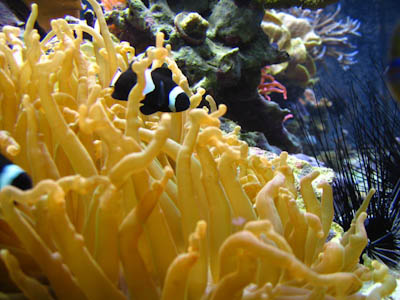 |
After passing through the skimmer, the water passes though a macroalgae refugium before draining into the sump. This is where the calcium reactor and GFO Reactor are located. The sump is covered by a leftover piece of Starboard to help minimize humidity in the room. From the sump, water is either returned to the display or to various other tanks used for captive propagation in the tank room. My current frag tank was my previous reef aquarium that I shortened to 24 inches in length. I am also running a 2’ x 2’ bubble-tipped anemone (BTA) propagation tank.
With these large tanks, house humidity must always be a consideration. I have done two things to address this issue. I cut a cold air return into the tank room. It sucks warm humid air from the tank room into the heating and cooling system, where it can be dehumidified. When the outside temperature allows us to turn off the house furnace or AC I have installed an exhaust fan that automatically turns on when temperature or humidity levels in the room get above a set point. The exhaust fan is set to never run when the furnace or AC are turned on.
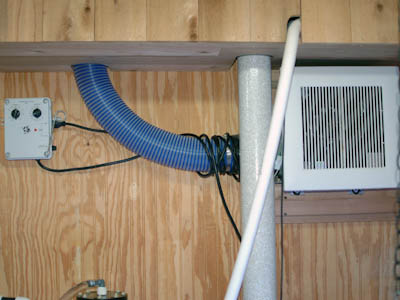 |
System Profile
• Display tank: 400 US gallons aquarium (80” long x 40” wide x 30” high)
• Skimmer: GEO custom needle wheel with Reeflo pump
• Controller: Neptune Apex
• Chemical Filters: Carbon and GFO
• RO/DI: Buckeye Field Supply 100GPD
• Calcium Reactor: GEO 818
• Lighting: 4x x 400w Metal Halide in Lumen Arc III reflectors
• Bulbs: Ushio 14000K
• Supplemental Lighting: 2x 70” VHO Super Actinics
• Return Pump: Iwaki 100RLT
Feeding and Supplements
We all know this can be an expensive hobby. I try to save money everywhere I can without sacrificing quality. For the past 5 years I have been making my own frozen fish food. Not only is it significantly cheaper than the commercially available foods, but my fish and corals devour it like no other food I have tried. It is also a great food for new arrivals that are hesitant to eat.
|
Mantis' Prime Reef Food
Roughly 3/4lbs each of the following:
Mix the above ingredients in a blender, until coarsely blended. |
|
Then stir in the following ingredients:
Pour into Ziploc bag and freeze flat. Feed as needed. |
This food is full of great amino acids for my fish and corals. I don’t make any other regular additions to the tank.
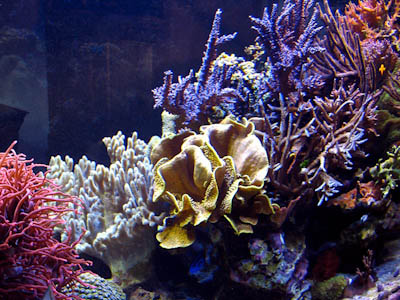 |
Have you ever wondered what the perfect commercial salt mix is? For me, it is a mixture of two commercial brands where I mix equal parts Instant Ocean and Oceanic. Instant Ocean when mixed alone is very high in alkalinity, whereas Oceanic is high in calcium and magnesium. Mixed in equal parts with my reverse osmosis water the values are as follows:
Alk: 9-10 dkh
Cal: 450 ppm
Mag: 1250 ppm
These values match the parameter goals for my aquarium and I find the cost of the two salts do not break the bank.
|
Water Parameters:
|
Livestock
My tank is home to many unique creatures, but by far the star of show is my 24’ long x 16” wide Derasa clam (Tridacna derasa). Powerful as well as beautiful, “Clamy” as we like to call him can shoot jets of water out of the tank and onto our floor. In addition, when clams get really large they no longer need their foot, which has proved to be quite a challenge. You see, Clamy liked to move around the tank and he did not care how many things he would knock over along the way. In the past, I would try to pen him in with rocks as best I could, but eventually Clamy would win. Then one day I had a great idea. Using a large 24” diameter muck bucket and Aragocrete I made a Clamy playpen. This large rock-donut works perfectly and he sits on top of it like a swimmer in an inner tube.
 |
Most of the corals in my system were grown from frags I acquired locally from the many heavily attended All Ohio Frag Swaps that our local club, CORA, and the Cleveland area club, CSEA, hold bi-annually.
I wanted to have such a large tank so I could have room for lots of different corals, SPS, softies, LPS, gorgonians, BTAs. I even have a section of green star polyps for my wife. She loves them, and I love her, so every couple of months I go in and keep them in check.
|
Fish:
|
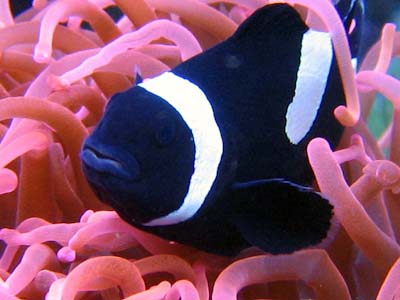 |
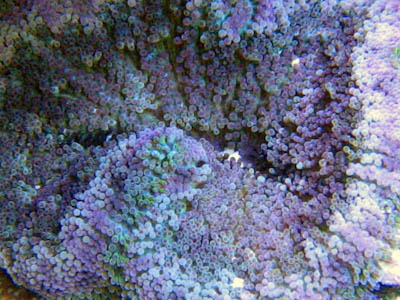 |
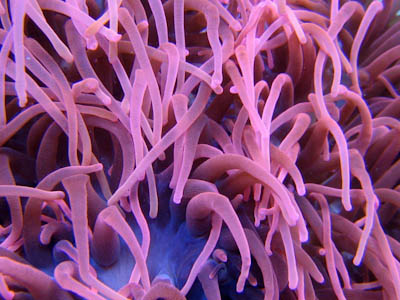 |
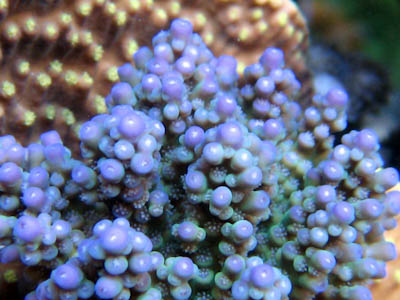 |
Acknowledgements
Over the years we have met so many new friends and acquaintances who share our passion for this hobby. Reef Central is responsible for joining us together to form this community. I would like to thank the RC staff for this incredible TOTM honor. I also must thank our local reef club, CORA. From the club's humble beginnings we have come a long way together. Most importantly, I must thank my wife, Maryann, for her love and support over the past 20 years. Without you honey, nothing else matters.
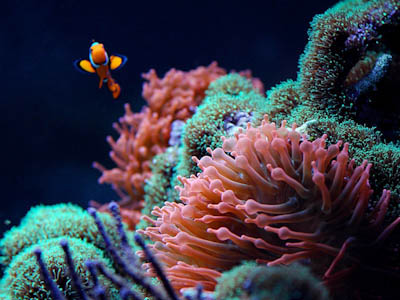 |
Feel free to comment or ask questions about my tank in the Tank of the Month thread on Reef Central.



